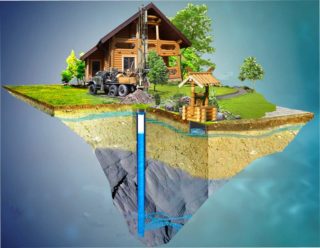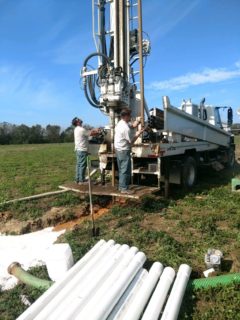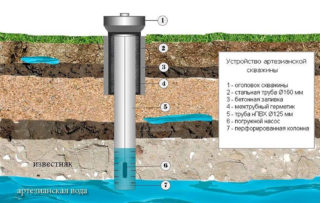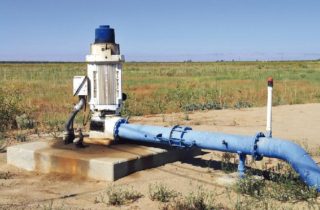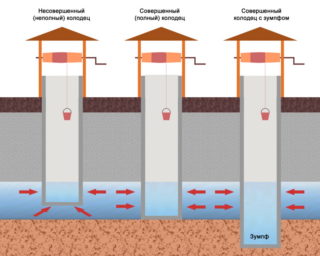In many private plots, and sometimes even several entire villages, an underground well decides the water supply. A water well is drilled deep into the earth and, if there is an underground source of water, pumps it out for human needs. Such an underground source can approximately work from 5 to 50 years, depending on the depth of the well and the source itself, how much it is rich in groundwater. There are several classifications and subspecies of wells, and they also have different purposes. Depending on the purpose of the well, the method of drilling wells is selected. The most important thing is to remember that it is better to carry out all work with professional equipment and hire specialists. We will talk about this in this article.
What classifications of wells can be
- Exploration.
- Filtering.
- Artesian.
- Industrial wells.
For drilling wells and wells, special equipment is used, it can only differ in width and depth, and the principle of operation is the same everywhere, regardless of the subspecies.
To check for the presence of a water source, you must first perform a test drill. It also has its own types and depends on the initial availability of soil. Well drilling is not cheap, so you should be careful not to spend extra money. To do this, you must correctly select one of the types of verification: rotary, core, snack.
The first method is the cheapest and most profitable for verification, it does not imply the presence of complex expensive equipment, but if it was not possible to find a water source at a high level, then the second two verification methods should be applied, they will allow you to find out the depth of groundwater at a lower distance from the surface.
Therefore, before proceeding and choosing which type of wells you need to drill, you should decide on the types of wells, and then understand which type of drilling is suitable for it.
Mapping well
Basically, when drilling, pipes of light alloys are used, if these are not deep wells, then up to 24 mm, during deep drilling of pipes with a diameter of 150 to 200 m.This type of well is also called prospecting and mapping, as they are drilled at the stage of survey work in order to identify the geological and hydrogeological structure of the site and the prospects for future drilling. Another distinctive feature is the fact that this method is chosen when drilling unstable rocks.
Exploration
In exploration wells, partial or complete core sampling is performed. Kern, as this is the name of a rock sample, which is intended for a specific type of drilling. Exploration drilling is characterized by a large diameter of pipes, since the need for research is pursued, and the larger the area, the more accurate the definition of the aquifer. If, according to the results of the study, the purpose of the well will be exploration and production, then a pump is placed at the end of the pipe for pumping out water.
Artesian
Well on the sand
A sand well is the simplest of the types of wells. An additional sand filter is located at the bottom. The drilling of such wells continues until the water is produced from the sandy soil up to one cubic meter per hour. The depth of drilling sand wells is not great, it reaches from fifteen to thirty-five meters in depth. With proper construction and drilling, its operation can take up to a year.
Water from such wells can be drinking water, and not only for irrigation or industrial purposes, unless, of course, an additional filter is installed and cleaned before use. The whole process of drilling for water is not as simple as it seems, drilling takes quite a long time and a lot of effort. Be sure to contact professionals who understand this and will be able to drill a well with high quality. Also, determining the location of drilling and finding water is not as easy as it seems, you cannot just select a site by eye and start digging. In addition to the water extraction process itself, the sand filter itself plays an important role, which allows you to improve the flow itself and the life of the well.
Industrial
Only in contrast to artesian wells, industrial drilling is considered and is more difficult, since complex industrial equipment and special pipes with a cross section of at least 219 mm are used. Industrial wells are designed to provide water to large enterprises, cities and agricultural industries. Production wells are produced from 100 m3 / hour.
Perfect well
The best option is to make a perfect well. Its bottom should be at the level of the aquifer, which guarantees drying out only if the aquifer itself depletes and dries up. There is only a seasonal influence, but it is just as uncritical. The shaft of such a well can go through, and be in a depression only for 1-2 rings. Accordingly, a recess is created, which makes a buffer tank where water accumulates. In this way, the bottom of a perfect well sinks lower, and the water itself and the water column are larger. For a private plot, this is an ideal building option.
Inspection well
The observation well is made of precast concrete or bricks on the water supply network. Most of the private houses that are located in the villages are usually connected to the central water supply.But some additionally cut a highway at the border of the site, a pipe that runs to a residential building. The central water supply system is always buried in the ground, and for the tie-in, a recess is built in the form of a well, from which it takes water into the house. A faucet is mounted on the spot, and a meter is placed on the water. In fact, the owners themselves do not look for groundwater, but take it directly from the central water supply.
Before drilling wells, it is necessary to organize and contact professionals, be sure to take into account the communication schemes for the drilling site, take into account the level of the earth's surface slope. Of course, in order to determine what type of wells you need to drill, you need to know why and in what quantities water will be consumed. If for local use and provided that there is centralized water, then it is better to choose a viewing well. To provide the village with underground water, of course, a permit for the construction of industrial wells is taken.

